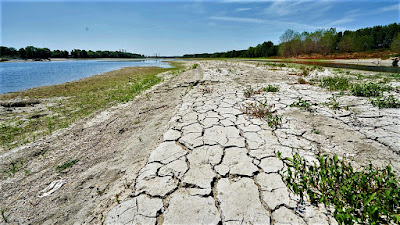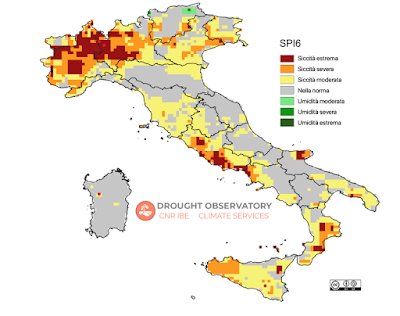While a declaration of emergency is expected, what is politics doing to alleviate the drought crisis?
It has been dry in Italy for an extended length of time, which has had obvious impacts, but those effects may not have yet showed their worst aspect. This has led to a water problem in the country. Even if there have been storms in Northern Italy, the predictions don’t seem very promising, and the most of the summer is yet to come. We are aware that an emergency situation exists since the first round of rationing has already been implemented, and certain regions are still waiting for a state of emergency to be declared. But in a more tangible sense, what is politics doing to solve the situation? We had a conversation about it today with Maria Spena, who is the vice president of the Agriculture Commission of the Chamber of Deputies, and Eleonora Evi, who is a member of the European Parliament’s Committee for the Environment, Public Health, and Food Safety. Both of these women are experts in the field.
The drought situation in Italy today
The temps of summer began much sooner than forecasted as well. The Drought Observatory of the National Research Council (CNR) emphasized that temperatures in June were at levels that are typical of July’s temperatures. The concern is that they won’t go down, and in July and August, temperatures that are again projected to be above normal are anticipated. The little amount of precipitation that we are forecast to get will only provide advantages of a restricted and isolated kind.
The decrease in precipitation, the lack of snow in the Alps, the dryness of the land, and the rise in temperature are all contributing factors that are depleting Italy’s water supplies. The North was the first region to be affected by the drought, but now the Center and the South are also beginning to feel its effects. Since the beginning of the year, the regions that have been most severely affected by drought are those located in the northwestern section of the country, in particular Piedmont and Lombardy. There has been a moderate to severe decrease in rainfall in several sections of Campania, Puglia, Calabria, and Sicily. The region of Lazio in the center of the country has been hit the worst by the lack of precipitation. As we have seen, one of the causes of drought is a structural issue, and this is in addition to the meteorological abnormalities that might contribute to it. Now, the Regions are waiting for the government to declare a state of emergency in order to understand not only how the crisis management will be centralized but also how the crisis itself will be managed.
Drought, crisis between crises: what politics wants to do in Italy
The challenges brought on by the epidemic and the conflict in Ukraine, which have made it impossible for the government to make choices and have made life tough for families and companies, have been followed by the crises brought on by the drought. The drought has made an already difficult situation even more complicated by adding to the existing problems. In the meanwhile, while the Regions are waiting for a state of emergency to be declared, which should occur in conjunction with a DPCM, they are moving about in no particular sequence. The Po, which just hit a new record low, has become the symbol of this catastrophe.
“Water is like air and the light; it is a necessary good and we must safeguard it from any waste,” said Maria Spena, a deputy for Forza Italia and vice head of the Agriculture Commission of the Chamber of Deputies in Italy. On the other hand, the declaration of a state of emergency, which will be carried out by means of a “drought edict,” has not yet been made: “Regarding the Dpcm drought, it will take some more time, but the government is working on a solution, and within the next two weeks, a plan will be developed. The drought disaster had been anticipated, and the prerequisites were there “. What contingency plans does politics have in place to cope with the crisis? Short-term and medium-term solutions are available as follows:”
There has been much discussion regarding the region’s limited capacity to store rainwater, which could be remedied by constructing a capillary network of reservoirs in the region. “We have proposed the projects of 200 new reservoirs in the region to collect water, a way also to produce energy, through hydroelectricity and photovoltaics with floating plants,” said the researchers who came up with the idea. In the near future, approximately one billion euros are available to finance projects of a similar nature through a CIS, which stands for a contract for institutional development. This contract will be managed by the structure of Mara Carfagna, who is the Minister for the South and Territorial Cohesion. The money comes from the state as well as subsidies from the European Union: “According to Spena, “We have also requested in the immediate term to define a CIS on the subject of water resources in order to include the territories and have finances available.” The mechanism has already been created by the Ministry for the South, and we will be able to get rid of around 1 billion euros by following processes that are similar to those of the NRP.
We must also foresee a new recovery to tackle the drought along with the problems of war, says Spena. We must provide funds in the next law of budget and asking for changes from the EU Commission to allow ad hoc funding on water system infrastructures, including to ensure food security.
A hand from Europe
Even in Brussels, discussions on the drought are taking place in order to have a better understanding of how to combat an issue that is not unique to Italy. Today, I had a conversation on this topic with Eleonora Evi, who is a Member of the European Parliament (MEP) for the European Greens (Green Europe) and a member of the Commission for the Environment, Public Health, and Food Safety in the European Parliament. “On the topic of drought, there are recommendations and rules that have been circulating for some time, said Evi. “Unlike Minister Cingolani, we feel that it is not a transient occurrence,” Evi stated. For instance, the rule on the use of water was authorized within the framework of the circular economy, and it suggests that we reuse treated wastewater for agricultural purposes. This is something that we should do “.
In the short term, the residual funds of the CAP, also known as the common agricultural policy of the European Union, will be able to be used to assist farms that are having financial difficulties. This represents a budget of approximately 1.4 billion euros; however, the timing of this assistance is still unknown. “There will be the possibility of using the residues of the 2014-2020 CAP to help farmers, with direct payments – Evi’s indication – They can be spent by October 2023 and should arrive shortly, even if it is difficult to give dates” “There will be the possibility of using the residues of the 2014-2020 CAP to help farmers, with direct payments – Evi’s indication – They can be spent by October 2023.
In addition, there is need for improvement in the following guidelines already in place: “For instance, the European Union regulation on energy efficiency is deficient: there is no relationship with water,” Evi points out, “and this is a problem.” We are well aware of the strong connection that exists between the use of water and the use of energy (water is used in the distribution of energy), but we also know that water is required for the production of energy (for the steam of thermoelectric plants, for example). must articulate, with specificity, their short-, medium-, and long-term water usage goals.
In addition to this, there is the Pnrr; however, the resources that have been allotted to the water network are not in line with the actual needs: “There are resources for 900 million euros to put their hands on the water network, but they are crumbs because the estimates speak of interventions needed for 20 billion euros,” Evi points out. In addition to these amounts, an additional two billion euros are required to cover the costs of modernizing, completing, and performing special maintenance on Italy’s infrastructure for water diversion, storage, and primary supply.
Source: TODAY









+ There are no comments
Add yours